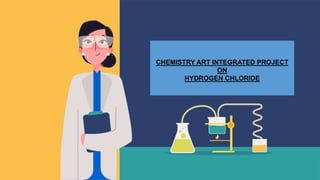CHEMISTRY ART INTEGRATED PROJECT.pptx
•Download as PPTX, PDF•
0 likes•3 views
hydrogen chloride
Report
Share
Report
Share

Recommended
Recommended
More Related Content
Similar to CHEMISTRY ART INTEGRATED PROJECT.pptx
Similar to CHEMISTRY ART INTEGRATED PROJECT.pptx (20)
namma_kalvi_12th_chemistry_unit_11_ppt_material_em_219536.pptx

namma_kalvi_12th_chemistry_unit_11_ppt_material_em_219536.pptx
Recently uploaded
Recently uploaded (20)
In-pond Race way systems for Aquaculture (IPRS).pptx

In-pond Race way systems for Aquaculture (IPRS).pptx
Efficient spin-up of Earth System Models usingsequence acceleration

Efficient spin-up of Earth System Models usingsequence acceleration
WASP-69b’s Escaping Envelope Is Confined to a Tail Extending at Least 7 Rp

WASP-69b’s Escaping Envelope Is Confined to a Tail Extending at Least 7 Rp
Manganese‐RichSandstonesasanIndicatorofAncientOxic LakeWaterConditionsinGale...

Manganese‐RichSandstonesasanIndicatorofAncientOxic LakeWaterConditionsinGale...
Factor Causing low production and physiology of mamary Gland

Factor Causing low production and physiology of mamary Gland
X-rays from a Central “Exhaust Vent” of the Galactic Center Chimney

X-rays from a Central “Exhaust Vent” of the Galactic Center Chimney
Heat Units in plant physiology and the importance of Growing Degree days

Heat Units in plant physiology and the importance of Growing Degree days
Biochemistry and Biomolecules - Science - 9th Grade by Slidesgo.pptx

Biochemistry and Biomolecules - Science - 9th Grade by Slidesgo.pptx
Isolation of AMF by wet sieving and decantation method pptx

Isolation of AMF by wet sieving and decantation method pptx
GBSN - Microbiology (Unit 6) Human and Microbial interaction

GBSN - Microbiology (Unit 6) Human and Microbial interaction
Mining Activity and Investment Opportunity in Myanmar.pptx

Mining Activity and Investment Opportunity in Myanmar.pptx
CHEMISTRY ART INTEGRATED PROJECT.pptx
- 1. CHEMISTRY ART INTEGRATED PROJECT ON HYDROGEN CHLORIDE
- 2. INTRODUCTION PREPARATION OF HYDROGEN CHLORIDE PROPERTIES OF HYDROGEN CHLORIDE USES OF HYDROGEN CHLORIDE
- 3. • . HYDROGEN CHLORIDE – • The compound hydrogen chloride has the chemical formula HCI and as such is a hydrogen halide. • Hydrogen chloride is a diatomic molecule, consisting of a hydrogen atom H and a chlorine atom Cl connected by a polar covalent bond. • The chlorine atom is much more electronegative • than the hydrogen atom, which makes this bond polar. • Consequently, the molecule has a large dipole moment with a negative partial charge (δ−) at the chlorine atom and a positive partial charge (δ+) at the hydrogen atom.
- 4. PREPARATION OF HYDROGEN CHLORIDE - Hydrogen Chloride is produced in the laboratory by treating sodium chloride with concentrated sulphuric acid. Then, this mixture is heated up to 420K. NaCl + H2SO4 → NaHSO4 + HCl Sodium bisulphate is obtained as a by-product which is insoluble. Therefore, it is further mixed with more sodium chloride. This mixture has to be further warmed to a higher temperature of around 823K. It gives dissolvable sodium sulfate and HCl gas. NaHSO4 + NaCl → Na2SO4 + HCl This HCl is dried by treating it with concentrated sulphuric acid. 420K 823K
- 5. PROPERTIES OF HYDROGEN CHLORIDE = 1. Hydrogen Chloride is a vapid gas. 2. It has a very sharp and pungent odour. 3. Boiling point of hydrogen chloride is 189K. 4. Freezing point of hydrogen chloride is 159K. 5. It is extremely soluble in water. An aqueous solution of Hydrogen Chloride is known as the hydrochloric acid. 6. HCI decomposes salts of weaker acids. 7. It reacts with NH3 and gives white fumes of NH4Cl. NH3 + HCL NH4CL 8. Hydrochloric acid has a higher dissociation constant and is, therefore, a strong acid. 9. Noble metals react with a mixture of nitric acid and hydrochloric acid in the proportion of 1:3. This arrangement what we call Aqua Regia. 10. Gaseous hydrogen chloride reacts with active metals and their oxides, hydroxides, and carbonates to produce chlorides
- 6. USES OF HYDROGEN CHLORIDE - 1. HCl is used in the preparation of chlorine, aqua regia, and other chlorides. 2. It is used as a solvent to dissolve noble gases. 3. It acts as a reagent in laboratories. 4. It is used for extracting glue from bones and purified bone black. 5. It is also a common ingredient in the fabrication of glucose from corn starch. 6. Saturated arrangement of zinc chloride in dilute hydrochloric acid is used in removing the contaminations on a metal surface prior to welding or electroplating.
- 7. SOME IMPORTANT REACTION - • Reaction with Sodium Carbonate: Na2CO3 + 2HCl → 2NaCl + CO2↑ + H2O • Reaction with Sodium Bicarbonate: NaHCO3 + HCl → NaCl + CO2↑ + H2O • Reaction with Sodium Sulphate: Na2SO3 + 2HCl → 2NaCl + SO2↑ + H2O
- 8. THANK YOU